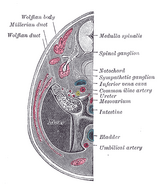Assessment |
Biopsychology |
Comparative |
Cognitive |
Developmental |
Language |
Individual differences |
Personality |
Philosophy |
Social |
Methods |
Statistics |
Clinical |
Educational |
Industrial |
Professional items |
World psychology |
Biological: Behavioural genetics · Evolutionary psychology · Neuroanatomy · Neurochemistry · Neuroendocrinology · Neuroscience · Psychoneuroimmunology · Physiological Psychology · Psychopharmacology (Index, Outline)
| Embryology: Müllerian ducts | ||
|---|---|---|
| Urogenital sinus of female human embryo of eight and a half to nine weeks old. | ||
| Tail end of human embryo, from eight and a half to nine weeks old. | ||
| Latin | d. paramesonephricus | |
| Gray's | subject #252 1206 | |
| System | ||
| Carnegie stage | 17 | |
| Days | {{{Days}}} | |
| Precursor | Intermediate mesoderm | |
| Gives rise to | ||
| MeSH | A16.254.570 | |
| Dorlands/Elsevier | d_29/12315002 | |
The Müllerian ducts (or paramesonephric ducts) are paired ducts of the embryo which run down the lateral sides of the urogenital ridge and terminate at the mullerian eminence in the primitive urogenital sinus. In the female, it will develop to form the fallopian tubes, uterus, and the upper portion of the vagina. It is tissue of mesodermal origin.
Development
Müllerian duct (blue) develops in females (middle image) and degenerates in males (bottom).
Müllerian duct develops in females and degenerates in males.
Regulation of development
The development of the Müllerian ducts is controlled by the presence or absence of "AMH", or Anti-müllerian hormone (also known as "MIF" for "Müllerian inhibiting factor", or "MIH" for "Müllerian inhibiting hormone").
| male embryogenesis | The testes produce AMH and as a result the development of the Müllerian ducts is inhibited. | Disturbances can lead to persistent müllerian duct syndrome. | The ducts disappear except for the vestigial vagina masculina and the appendix testis. |
| female embryogenesis | The absence of AMH results in the development of female reproductive organs, as noted above. | Disturbance in the development may result in uterine absence (Mullerian agenesis) or uterine malformations. | The ducts develop into the upper vagina, cervix, uterus and oviducts. |
Eponym
They are named after Johannes Peter Müller, a physiologist who described these ducts in his text "Bildungsgeschichte der Genitalien" in 1830.
Additional images
See also
- Defeminization
- prostatic utricle
- List of homologues of the human reproductive system
- Sexual differentiation
- Wolffian duct
External links
Prenatal development/mammalian embryogenesis - Development of the urinary and reproductive organs | |
|---|---|
| General Urinary/Reproductive system |
Cloacal membrane - Cloaca - Urethral groove - Urogenital sinus - Urachus - Urogenital folds |
| Kidney development |
Nephrogenic cord - Nephrotome - Pronephros - Mesonephros (Mesonephric tubules) |
| Fetal genital development - primarily internal |
Gonadal ridge - Sex cord (Cortical cords, Testis cords) |
| Primarily external |
Genital tubercle - Phallus - Labioscrotal folds |
|
see also list of homologues of the human reproductive system | |
| This page uses Creative Commons Licensed content from Wikipedia (view authors). |
